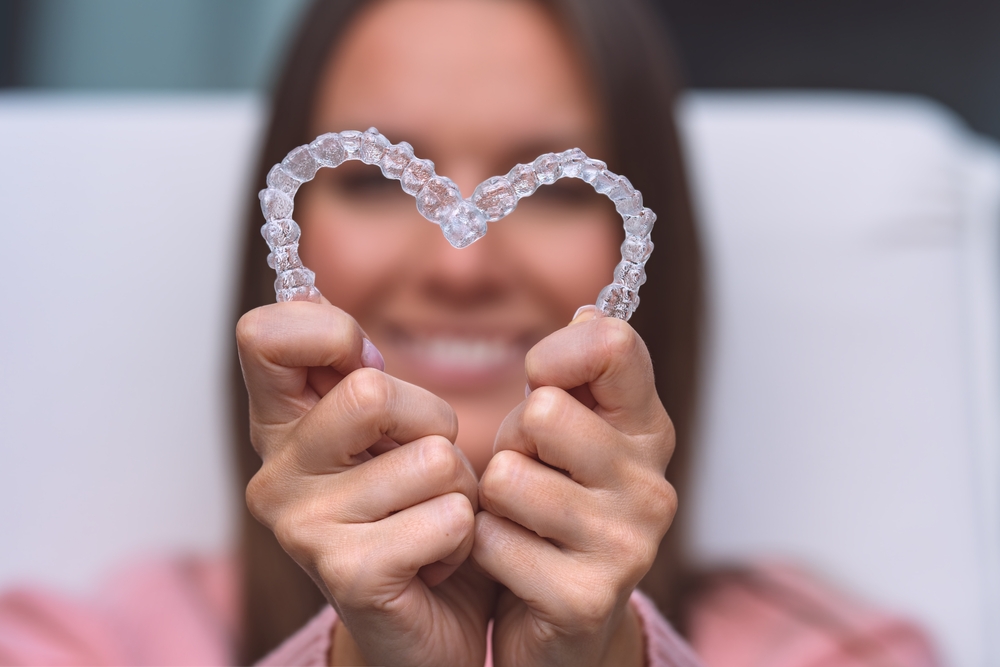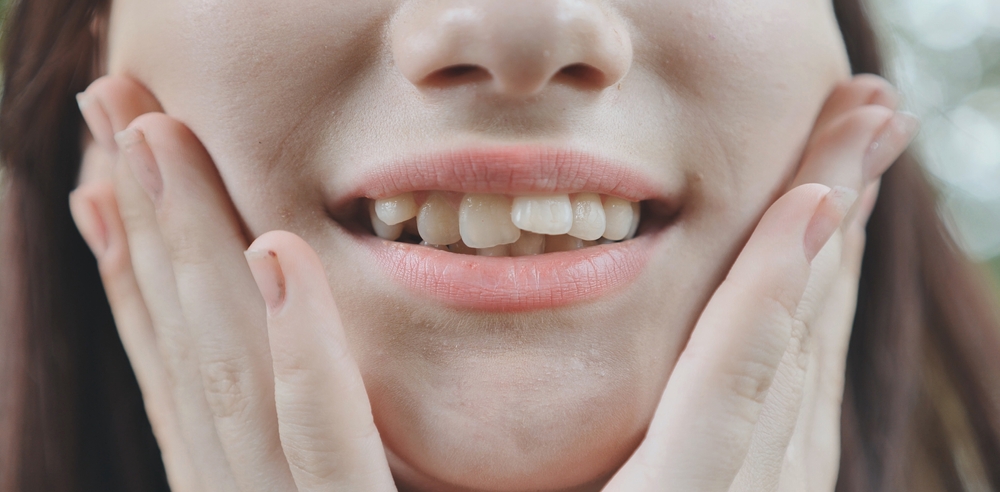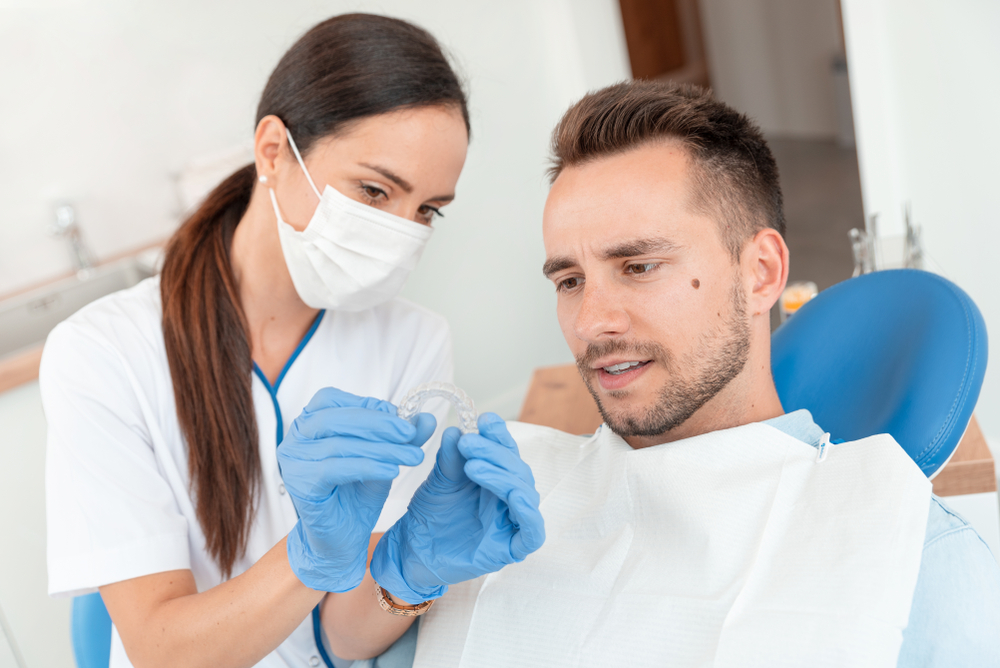1812 E. Broadway St.
Pearland, TX 77581
As a leading Brazoria County dental practice, Pearland Dental Group understands the impact that an overbite can have on both your oral health and confidence. Thanks to modern orthodontic treatments, Invisalign® clear aligners offer an effective and discreet solution for correcting overbites without traditional braces.
Our experienced Pearland Invisalign providers, Dr. Rushi Dave and Dr. Milli Shah, have helped countless patients achieve their ideal smiles through customized Invisalign treatment plans. Learn more about how Invisalign clear aligner treatment can help alleviate your overbite by dialing (281) 993-9900.
An overbite occurs when your upper front teeth significantly overlap your lower teeth. While a slight overbite is normal, excessive overbites can lead to various oral health complications and aesthetic concerns. At Pearland Dental Group, we carefully evaluate each patient’s specific condition to determine the most effective treatment approach.
At Pearland Dental Group, Dr. Dave and Dr. Shah believe that understanding what causes overbites helps our patients make informed decisions about their treatment. Here are the most common factors that can lead to overbite development:
Just like you might inherit your eye color or height from your parents, you can also inherit your jaw structure and tooth positioning due to genetics. Some people naturally develop a smaller lower jaw or a larger upper jaw due to their genes. This is why we often see similar bite patterns running in families and why we always ask about your family’s dental history during your consultation.
When children use pacifiers for too long or continue thumb-sucking past age three, these habits can affect how their teeth and jaws develop. The constant pressure from sucking pushes the front teeth forward and can change how the jaw grows. Even after these habits stop, the effects on tooth alignment can remain, which is why early dental check-ups are so important.
Tongue thrust happens when someone’s tongue pushes forward against their teeth instead of resting against the roof of their mouth when they swallow or speak. Think of it like repeatedly pushing against a fence – eventually, that fence might start to lean. The same thing happens with teeth when the tongue constantly pushes against them, gradually creating an overbite.
Sometimes the upper and lower jaws grow at different rates or in different ways. When jaw development issues occur, it can cause the upper teeth to overlap the lower teeth too much, creating an overbite that needs correction.
When teeth are missing or come in at odd angles, it can affect your entire bite. Think of your teeth like books on a shelf – if you remove a book or place one at an angle, the others might shift to fill the space or accommodate the change. This shifting can lead to bite problems over time.
Other Contributing Factors:
Understanding these causes helps our Pearland Invisalign providers develop the most effective treatment plan for your specific situation. During your consultation, we’ll discuss which factors may have contributed to your overbite and how Invisalign aligner trays can help correct it.
Invisalign offers an effective and discreet solution for correcting overbites, utilizing custom-made clear aligners to gradually shift teeth into their proper positions. This innovative treatment approach provides patients with a comfortable and aesthetically pleasing alternative to traditional braces. Let’s explore the details of how Invisalign addresses overbites and why it’s an important treatment option.
The Invisalign clear aligner treatment process begins with a comprehensive assessment using advanced 3D imaging technology. This initial step is crucial as it allows for the creation of precise digital impressions of your teeth, enabling accurate treatment planning and visualization of expected outcomes. By utilizing this state-of-the-art technology, orthodontists can develop a tailored, personalized treatment plan that addresses your specific overbite concerns.
Invisalign works by applying controlled, gentle pressure to move teeth incrementally. This is achieved through a series of custom-designed aligners that gradually reposition both the upper and lower teeth. As you progress through each set of aligners, your teeth will slowly shift into their desired positions. Throughout the treatment, you’ll have regular progress evaluations to ensure that your teeth are moving as planned and to make any necessary adjustments to your treatment.
On average, overbite correction with Invisalign takes between 12 to 18 months. However, it’s important to note that treatment time can vary based on several factors. These factors include the severity of the overbite, the patient’s age and dental history, and compliance with wearing the aligners as directed by the orthodontist. Your orthodontist will provide you with a more accurate timeline based on your individual case.
Invisalign offers several significant advantages over traditional braces:
Addressing overbites is crucial for both oral and overall health. Left untreated, overbites can lead to a variety of dental problems as:
Invisalign has proven to be effective in treating various types of overbites:
While Invisalign treatment is generally more comfortable than traditional braces, patients may experience mild pressure or discomfort when switching to new aligners, typically lasting 2-3 days. This sensation is actually a sign that your treatment is working effectively, as it indicates your teeth are gradually moving into their proper positions.
Our Pearland Invisalign providers, Dr. Dave and Dr. Shah, work closely with each patient to ensure comfort throughout the treatment process and can recommend various methods to minimize any temporary discomfort, such as switching to new aligners before bedtime or using appropriate over-the-counter pain relievers when needed.
The ideal age for children to begin Invisalign treatment varies depending on their dental development, typically recommended once all permanent teeth have erupted, usually between ages 12-14. However, at Pearland Dental Group, we conduct comprehensive evaluations of younger patients to identify potential bite issues early and may recommend interceptive treatment options if necessary.
Our doctors will carefully monitor your child’s dental development and recommend the most appropriate time to begin treatment, taking into consideration factors such as tooth eruption patterns, jaw growth, and the child’s ability to comply with aligner wear requirements.
The duration of Invisalign treatment for overbite correction typically ranges from 12 to 24 months, depending on the severity of the misalignment and patient compliance with wearing the aligners for the recommended 20-22 hours per day.
Your specific treatment timeline will be determined during your initial consultation with our Pearland Invisalign providers, who will create a detailed treatment plan based on your unique needs. Regular progress checks every 6-8 weeks allow our team to monitor your treatment and make any necessary adjustments to ensure optimal results within the projected timeframe.
Don’t let an overbite impact your oral health and confidence any longer. At Pearland Dental Group, Dr. Dave and Dr. Shah are ready to help you fix overbite and achieve your best smile through personalized Invisalign treatment. We proudly serve patients throughout Pearland, League City, Sugar Land, and Houston, TX.
Contact our office today at (281)993-9900 to schedule your consultation and discover how our experienced Pearland Invisalign providers can help transform your smile with clear aligner therapy.




Our clinic offers all kinds of services and constantly study new
technology to add new custom services to the list
Phone: (281)993-9900
Address: 1812 E. Broadway St. Pearland, TX 77581
Copyright © 2021 Pearland Dental Group | Managed by Now Media Group